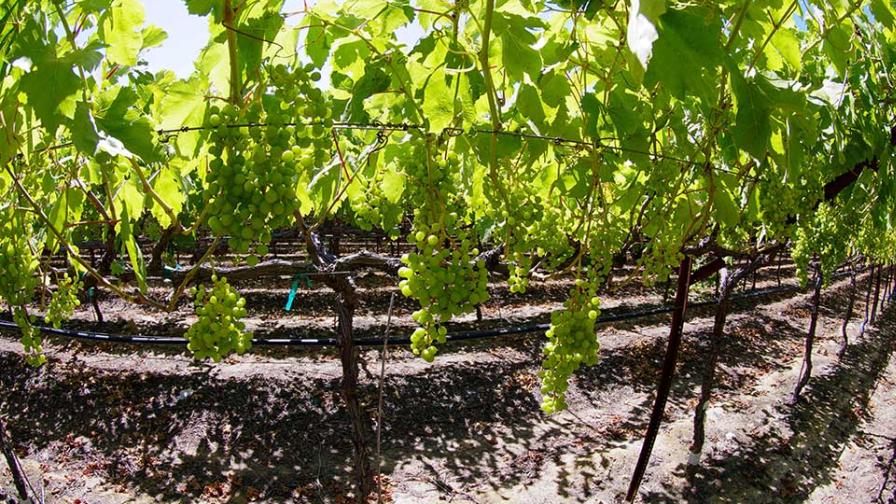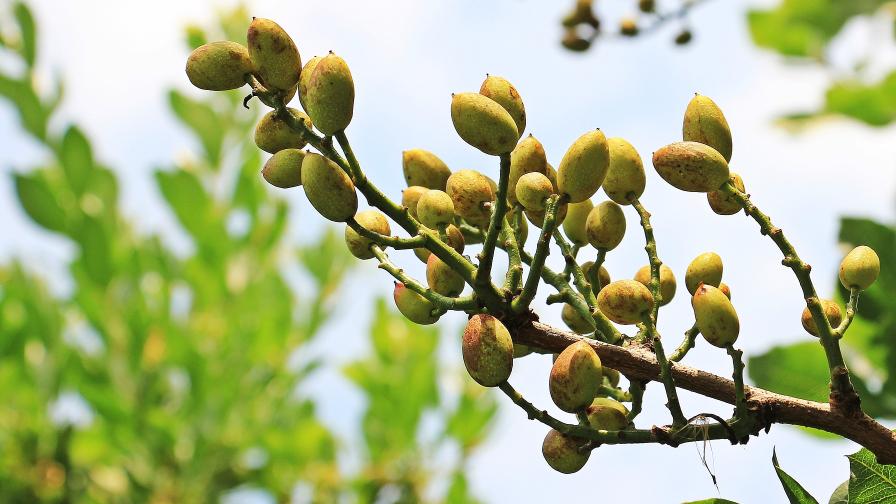Ways To Develop a Nitrogen Management Plan For Table Grapes

Nitrogen sufficiency symptoms in ‘Flame Seedless’ table grapes. In this photo, vines on the left are severely deficient in N fertilizer as evidenced by their low vigor and pale-green to yellow-green foliage.
Photo by Matthew Fidelibus
Nitrogen (N) fertilization may be needed to optimize the growth, yield, and fruit quality of table grapes in the San Joaquin Valley (SJV) of California. To get the most out of their fertilizer investment and minimize unwanted effects on the environment, growers should match a vine’s need for N with the amount of N applied. This can be achieved by routinely assessing the vine’s N status, estimating the quantity of N needed to support the vine’s annual growth, considering non-fertilizer sources of N, and applying N fertilizer when it is needed.
Vine N status is generally ascertained by observations paired with the laboratory analysis of plant tissues. Severe N deficiency is uncommonly observed, but easily recognized, in commercial vineyards of the SJV. N-deficient vines have short shoots with small leaves, with a pale green to yellow-green color. Vines with a less severe deficiency have lower than normal vigor, but their leaves may have a nearly normal, or normal, appearance.
Vines with adequate N status should sufficiently fill the trellis without excessive shading, whereas vines with excess N exhibit luxuriant growth of primary and lateral shoots, with large, dark green leaves on shoots with long internodes that may be flattened in cross section. Laboratory analysis can help confirm vine N status.
PETIOLES OR BLADES
In California, laboratory analyses are usually performed on petioles, though some people prefer to test blades. Laboratory reports will generally classify the samples as deficient, marginal, adequate, high, or toxic, according to standards developed for similar tissues and sampling times. Tissue N levels can change rapidly over the course of the season, especially around bloom. Therefore it is important to collect the samples at consistent developmental stages each year, typically at bloom (80% cap fall) and veraison.
Cultural practices such as pesticide applications, labor availability, and other factors can hinder timely tissue collection. Remote sensing has shown potential for detecting vine N status, and could help reduce labor needs, improve timeliness, and provide other potential benefits, including mapping of the spatial distribution of vine N status in a vineyard.
If visual assessment and laboratory analyses suggest the vines have high levels of N, then N fertilization may not be necessary for one or more seasons, especially if non-fertilizer sources of N are available and substantial. In such cases, the grower should continue to monitor vine N status.

Vines in this photo have much better N status, and this can be seen in their better overall growth and darker foliage color.
Photo by Matthew Fidelibus
REPLACING NITROGEN
If vine growth, yield, and tissue test results are normal and sufficient, growers should plan to replace the N in fruit, which is approximately 3 pounds N per ton of fruit. If yields and growth are low, and tissue test results are borderline or low, growers should consider replacing more than the amount of N in fruit, up to twice the amount of N in fruit. When replacing N, consider common non-fertilizer sources of N, including soil organic matter and nitrates (NO3) in well water, which can reduce the amount of fertilizer N needed.
The best time to apply N fertilizer is in late spring when the vines are rapidly growing and the demand for N is high. A high demand for N continues after fruit set, and split applications of N, with the first half applied a month after budbreak, and the second half at fruit set, can be very efficient.
Winter and early spring are poor times to apply N as vine demand is low, and the fertilizer is easily leached. Postharvest N applications may be effective for early to mid-season varieties, but late-season N applications should be avoided, as the vines should not be actively growing at that time, and several studies have shown relatively poor N recovery efficiency for postharvest N applications.
There is work being done to develop remote sensing of vine nutrient status. Imaging and lab test result data are paired and used to develop algorithms that can estimate vine N status from imaging data. This approach can generate vineyard N sufficiency maps.










